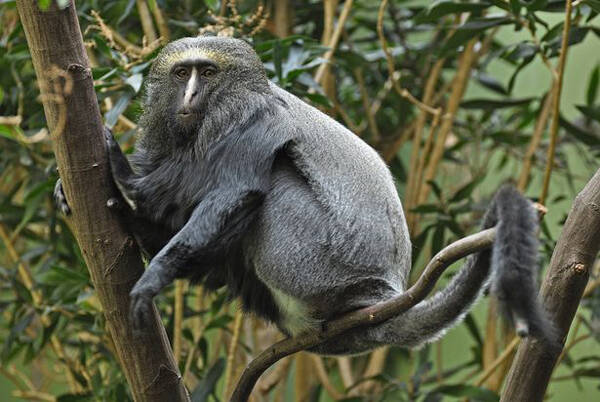Cercopithecus hamlyni
IUCN
LCBasic Information
Scientific classification
- name:Cercopithecus hamlyni
- Scientific Name:Cercopithecus hamlyni,Hamlyn’s Monkey,Hamlin's monkey, owl-faced monkey
- Outline:Primates
- Family:Cercopithecidae Cercopithecidae
Vital signs
- length:About 56 cm
- Weight:3.4-5.5kg
- lifetime:No verification information
Feature
Owl-like appearance
Distribution and Habitat
Owl-faced long-tailed monkeys are distributed in Congo, northwestern Rwanda and Uganda. They live on the edge of the virgin forest, in tropical rainforests, subtropical evergreen broad-leaved forests or mixed coniferous and broad-leaved forests below 3,000 meters above sea level.
Appearance
The owl-faced long-tailed monkey is 56 cm long, males weigh 5.5 kg, and females weigh 3.4 kg. It has an unusually large triangular face and a pair of large eyes, a round head, and a somewhat owl-like appearance. There are golden spots on the temples, a light yellow patch on the eyebrows, black cheeks, a white stripe in the middle of the nose, and dark gray fur all over the body, which is dense and hangs down from both ends like tassels. The rear end of the long tail and scrotum are bright blue, and the long tail is smooth, with a small tuft of unique brush-like hair at the end.
Details
Owl-faced long-tailed monkey (scientific name: Cercopithecus hamlyni) is also known as Hamlyn’s Monkey in English. It has 2 subspecies.

Owl-faced long-tailed monkeys live in trees and appear on cliffs in the forests on both sides of the river valley. They often move in groups and forage at dawn and dusk, feeding on leaves and wild fruits. They spend most of their time on the ground, with two peaks of daily activity, early morning or late afternoon or evening. Living in a small group, males have a strong sense of territory, but they are separated from neighboring groups to avoid serious conflicts as much as possible.
Owl-faced long-tailed monkeys eat fruits, insects and leaves. They use their rather large incisors to chew fruits and their flat molars to crush and grind hard seeds. Like other primates, they have cheek pouches, which are special sac-like structures located on both sides of the mouth that have the function of temporarily storing food. This has two advantages: in places where competition for fruits is fierce, the monkeys can grab as much food as possible without being taken away by other hungry monkeys, and at the same time, enzymes in their saliva help break down toxic compounds in the unripe fruits and seeds stored in the cheek pouches.
Owl-faced long-tailed monkeys breed year-round, and female monkeys can give birth every year. The gestation period is 5 months, and the young monkeys need 6 months of care. Only one monkey is born per litter. Even if the monkey is born in good condition, the mother monkey will be very nervous and rarely let the monkey leave her. The monkeys love to play. The monkeys reach sexual maturity at the age of 3 years old. Females will stay with their mothers, while males will leave.
The Owl-faced Vervet is listed as Vulnerable, with populations declining and continuing to decline. Political and military conflict is high throughout the species' range, exacerbating the identified threats. It is expected that the species' decline will continue in the face of a continued turbulent political climate, leading to a total population loss of more than 30% over a 30-year period (2010s).
Listed in the IUCN Red List of Primates, ver.: 2008 - Vulnerable (VU).
Protect wild animals and stop eating game.
Maintaining ecological balance is everyone's responsibility!








